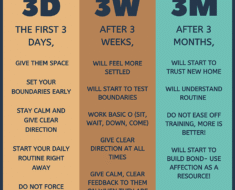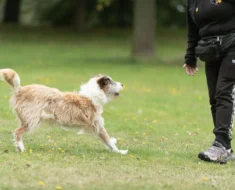Are you tired of watching your dog endlessly pace the yard or run along the fence? This restless behavior can be frustrating—for both you and your furry friend.
But what if you could turn that energy into something positive and calming? You’ll discover how simple pattern games can help stop yard pacing and fence running. These games don’t just distract your dog—they engage their mind and body in a way that reduces anxiety and boredom.
Keep reading to learn easy, effective steps that will bring peace to your yard and joy to your dog’s day.

Credit: www.acehardware.com
Causes Of Yard Pacing And Fence Running
Boredom and lack of stimulationoften cause dogs to pace or run along fences. Dogs need mental and physical activitiesto stay happy. Without these, they feel restless and start pacing.
Anxiety and stresscan make dogs act this way too. Changes in their environment or loud noises may trigger nervousness. This leads to repetitive behaviorslike fence running.
Territorial behavioris another cause. Dogs often patrol their yard to protect it. They may run along fences to check for intrudersor other animals.
Excess energy and exercise needsalso play a big part. Dogs with lots of energy need enough exercise. Without it, they release energy by pacing or running.
What Are Pattern Games
Pattern gameshelp dogs focus and calm their minds. They use simple repeated actionsthat dogs learn quickly. These games can reduce stressand stop behaviors like yard pacingand fence running. Dogs enjoy the mental challenge, which keeps them busy and happy.
These games also build trustbetween you and your dog. They teach patience and improve obedience. Playing pattern games regularly can make your dog feel more secure and less anxious.
| Type of Pattern Game | How It Works | Benefits |
|---|---|---|
| Touch Game | Dog touches a hand or object on cue | Improves focus and calmness |
| Circle Game | Dog walks around in a circle | Builds patience and control |
| Step Back Game | Dog steps back on command | Teaches self-control and listening |
Preparing For Pattern Game Training
Choose a quiet place with few distractions. This helps your dog focus better. A fenced yard or a small room works well. Make sure the area is safe and free from hazards.
Gather simple tools like treats, a clicker, and a leash. Treats should be small and tasty to keep your dog’s attention. A clicker can mark good behavior clearly.
| Training Goals | Details |
|---|---|
| Reduce pacing | Help your dog stay calm and still. |
| Stop fence running | Teach your dog to stay away from the fence. |
| Build focus | Improve your dog’s attention during training. |

Credit: www.amazon.com
Step-by-step Pattern Game Techniques
Start with simple patterns your dog can follow easily. Use clear, consistent movements or taps to show the pattern. Repeat the pattern slowly, so your dog understands. Praise your dog when it copies the pattern correctly. Keep sessions short to keep your dog interested.
Gradually make patterns more complex. Add more steps or change directions. Watch your dog’s response and adjust speed if needed. Complexity helps distract your dog from yard pacing and fence running. It also keeps their mind busy and calm.
Use commands like “wait,” “touch,” or “follow” with the patterns. Pair commands with hand signals or taps. This helps your dog learn to listen and focus. Practice commands during pattern games regularly. This builds better control and reduces unwanted pacing behavior.
Integrating Pattern Games Into Daily Routine
Set short, regular training sessionseach day. Keep sessions 5 to 10 minuteslong. Consistency helps dogs learn faster. Try to train at the same timeevery day.
Combine pattern games with daily walks or playtime. Exercise tired dogsare less likely to pace or run along fences. Physical activity reduces stressand calms energy.
| Step | What to Do | Why It Helps |
|---|---|---|
| 1. Schedule | Train daily, same time, short sessions | Builds habit and focus |
| 2. Exercise | Walk or play before training | Reduces excess energy |
| 3. Monitor | Watch dog’s behavior and progress | Adjust games and time as needed |

Credit: unfocussed.com
Additional Tips To Reduce Fence Running
Creating an interesting yardhelps keep dogs calm and busy. Adding safe plants, shade, and soft ground makes the area inviting. Toys like balls or chew items provide fun distractions. Rotating toys often keeps dogs curious and less bored.
Use distractionsduring times your dog tends to run or pace. Playing with a ball or tossing treats can redirect their energy. Puzzle toys that hide treats also help focus their mind away from the fence.
Praiseand rewardcalm behavior near the fence. Giving treats or petting when the dog stays calm teaches good habits. Avoid yelling or punishment, which can increase anxiety and fence running.
When To Seek Professional Help
Signs training isn’t workinginclude repeated pacing or fence running after weeks. Your dog may seem stressed or anxious despite your efforts. Lack of progress shows a need for expert help. If your dog’s behavior worsens or becomes unsafe, act quickly. Some dogs need special care beyond basic training.
Choosing a trainer or behavioristrequires checking their experience with anxious dogs. Look for someone who uses positive methods and understands dog behavior well. Ask about their success with similar problems. A good professional will tailor plans to your dog’s needs. Trust and clear communication are key to success.
Frequently Asked Questions
What Causes Yard Pacing And Fence Running In Dogs?
Yard pacing and fence running usually stem from boredom, anxiety, or lack of exercise. Dogs need mental and physical stimulation. Without it, they develop repetitive behaviors to release excess energy or stress.
How Do Pattern Games Reduce Pacing And Fence Running?
Pattern games engage dogs mentally and physically. These games break repetitive cycles by providing structured activities. They improve focus, reduce anxiety, and channel energy positively, helping stop pacing and fence running.
Can Pattern Games Be Used For All Dog Breeds?
Yes, pattern games are adaptable for all breeds and ages. They can be tailored to suit your dog’s energy level and intelligence, making them effective for managing pacing and fence running.
How Often Should I Play Pattern Games With My Dog?
Daily sessions of 10 to 15 minutes are ideal. Consistency helps dogs learn and stay engaged, reducing unwanted behaviors like yard pacing and fence running over time.
Conclusion
Stopping yard pacing and fence running needs patience and consistent effort. Pattern games help dogs focus and reduce stress. These activities keep your dog busy and calm. Practice daily with short sessions for best results. You will see your dog more relaxed over time.
A calm dog means a happier home for everyone. Keep trying, and enjoy the progress you make.





